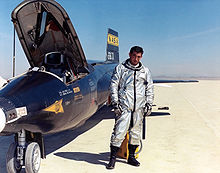- Michael J. Adams
-
Michael James Adams 
USAF Astronaut Nationality American Status Killed during mission Born May 5, 1930
Sacramento, CaliforniaDied November 15, 1967 (aged 37)
Near Johannesburg, CaliforniaOther occupation Test Pilot Rank Major, US Air Force Selection 1965 USAF MOL Group Missions Flight 191 Mission insignia 
Michael James Adams (May 5, 1930 – November 15, 1967) was an American aviator, engineer and USAF astronaut. He was the first US space mission fatality, according to the US definition.
Contents
Background
Military experience
Born in Sacramento, California, James graduated from Sacramento Junior College. He enlisted in the U.S. Air Force in 1950 and earned his pilot wings and commission in 1952 at Webb Air Force Base, Texas. He served as a fighter-bomber pilot during the Korean War, followed by 30 months with the 813th Fighter-Bomber Squadron at England Air Force Base, Louisiana and six months rotational duty at Chaumont Air Base in France.
Education and flight experience
In 1958, Adams received an aeronautical engineering degree from Oklahoma University and, after 18 months of astronautics study at Massachusetts Institute of Technology, was selected in 1962 for the Experimental Test Pilot School at Edwards Air Force Base, California. Here, he won the Honts Trophy as the best scholar and pilot in his class. Adams subsequently attended the Aerospace Research Pilot School (ARPS), graduating with honors in December 1963. He was one of four Edwards aerospace research pilots to participate in a five-month series of NASA moon landing practice tests at the Martin Company in Baltimore, Maryland. In November, 1965 he was selected to be an astronaut in the United States Air Force Manned Orbiting Laboratory program. In July 1966, Major Adams came to the North American X-15 program, a joint USAF/NASA project. He made his first X-15 flight on 6 October 1966 in the number one aircraft.
Death
Adams' seventh X-15 flight, flight 3-65-97, took place on 15 November 1967. He reached a peak altitude of 266,000 feet (81 km); the nose of the aircraft was off heading by 15 degrees to the right. While descending, at 230,000 feet (70 km) the aircraft encountered rapidly increasing aerodynamic pressure which impinged on the airframe, causing the X-15 to enter a violent Mach 5 spin. As the X-15 neared 65,000 feet, it was diving at Mach 3.93 and experiencing more than 15-g vertically (positive and negative), and 8-g laterally, which inevitably exceeded the design limits of the aircraft. The aircraft broke up 10 minutes and 35 seconds after launch, killing Adams. The United States Air Force posthumously awarded him astronaut Wings for his last flight.
An excerpt from NASA's biography page on Mike Adams discusses findings from the crash investigation:
- Ground parties scoured the countryside looking for wreckage; critical to the investigation was the film from the cockpit camera. The weekend after the accident, an unofficial FRC search party found the camera; disappointingly, the film cartridge was nowhere in sight. Engineers theorized that the film cassette, being lighter than the camera, might be further away, blown north by winds at altitude. FRC engineer Victor Horton organized a search and on 29 November, during the first pass over the area, Willard E. Dives found the cassette. Most puzzling was Adams' complete lack of awareness of major heading deviations in spite of accurately functioning cockpit instrumentation. The accident board concluded that he had allowed the aircraft to deviate as the result of a combination of distraction, misinterpretation of his instrumentation display, and possible vertigo. The electrical disturbance early in the flight degraded the overall effectiveness of the aircraft's control system and further added to pilot workload. The MH-96 adaptive control system then caused the airplane to break up during reentry.[1]
Adams remembered
In 1991, Adams' name was added to the Space Mirror Memorial at the Kennedy Space Center in Florida.
On June 8, 2004 a memorial monument to Adams was erected near the crash site, northwest of Randsburg, California.
Notes
References
- NASA X-15 Biography
- Thompson, Milton O. (1992) At The Edge Of Space: The X-15 Flight Program, Smithsonian Institution Press, Washington and London. ISBN 1-56098-107-5
External links
Categories:- 1930 births
- USAF astronauts
- American aviators
- Space program fatalities
- 1967 deaths
- X-15 program
- Aviators killed in aviation accidents or incidents in the United States
- Accidental deaths in California
- People from Sacramento, California
- USAF Test Pilot School alumni
- American test pilots
Wikimedia Foundation. 2010.
